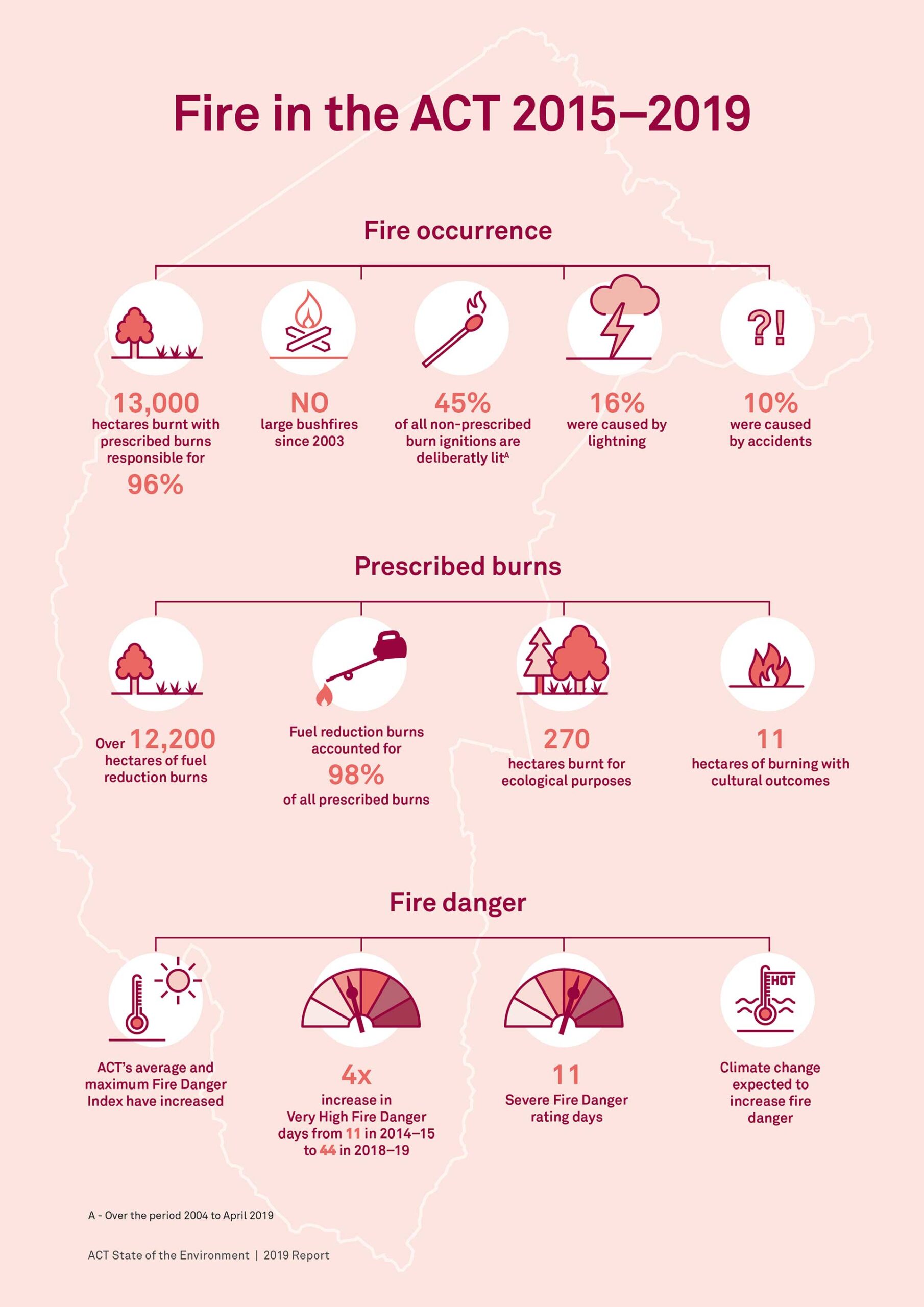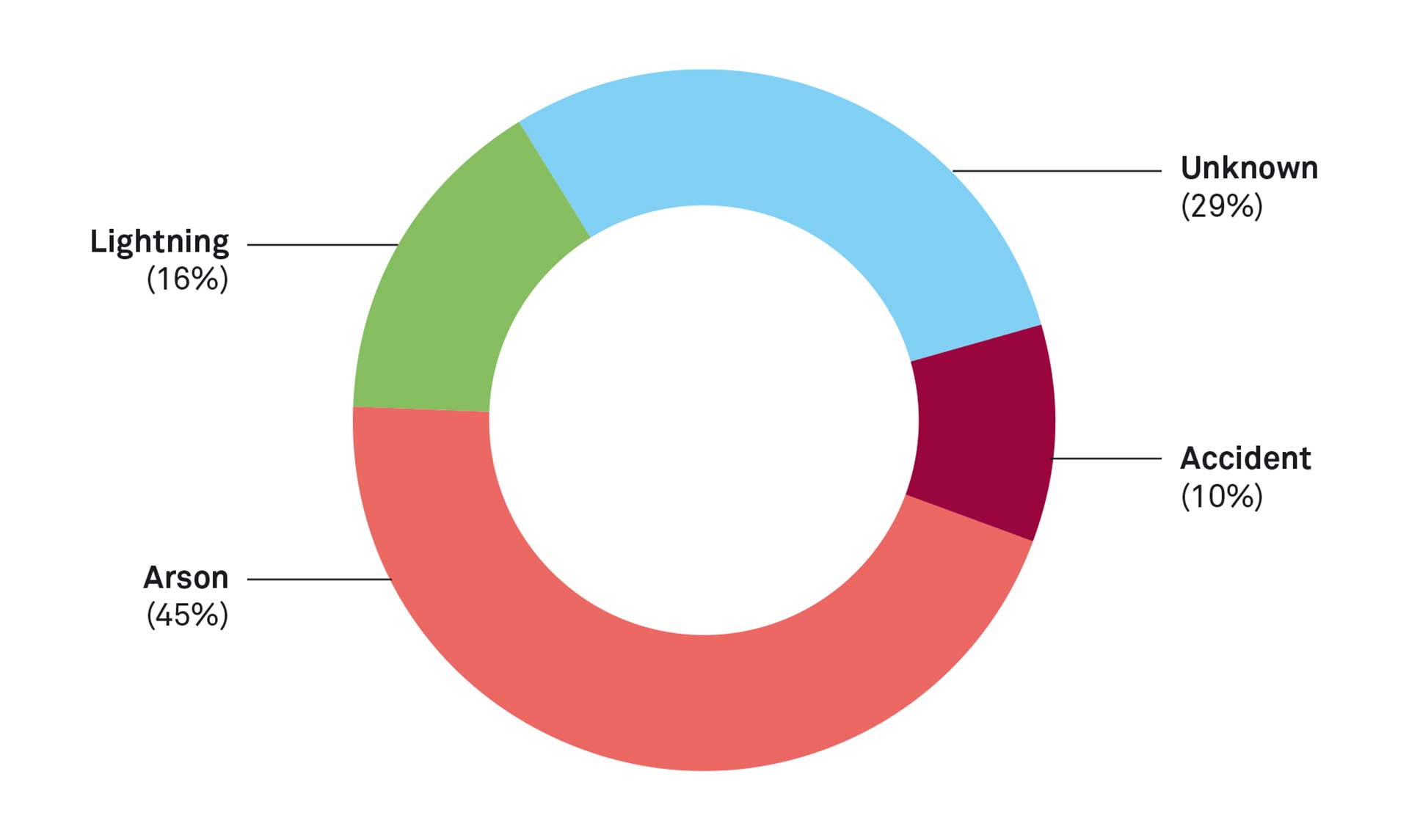The 2019-20 fire season
The 2019 ACT State of the Environment Report covered the period to June 2019, so did not include the 2019-20 bushfiresA fire that burns in grass, bush or woodland and can threate More. Information on these fires and their impacts has been added to this material in recognition of the devastating impacts on the region.
The 2019-20 fire season was one of the worst on record. Across Australia, a total of 24.2 million hectares were burnt. The fires affected life, property, the environment and community health. They were a consequence of climate change, which is contributing to more frequent heatwaves and more severe fire seasons that are starting earlier and lasting longer (see Climate is changing section).
During the summer, nearly 90,000 hectares were burnt. This is just under 40 per cent of the ACT’s total area.
The most significant bushfireA fire that burns in grass, bush or woodland and can threate More was the Orroral Valley fire which started on 27 January and burnt 82,700 hectares of the Namadgi National Park and 1,444 hectares of the Tidbinbilla Nature Reserve. Another 3,350 hectares of rural lands were also burnt. The fire threatened the township of Tharwa and the southern suburbs of Canberra, with residents warned to be ready to evacuate if necessary. Fortunately, there was no loss of human life or residential buildings.
Namadgi National Park was severely affected by the fire, with 80 per cent burnt. The park is an important ecological reserve containing critical ecosystemsA collection of interacting living and non-living things. A More such as threatened alpine bogs and wetlands, and providing habitats for many endangered plant and animal species (see Biodiversity section). Much of the Park has now burnt twice in 20 years, this will have significant consequences for many of the plant and animal species. The Park also holds significant Ngunnawal (see Ngunnawal Country section) and European cultural heritage. Namadgi National Park also is the source for the majority of Canberra’s drinking water supply (see Chapter 9). BushfireA fire that burns in grass, bush or woodland and can threate More smoke severely affected Canberra’s air quality (see Air pollution section).
More information on Australia’s 2019-20 fire season and the impacts on the ACT can be found HERE
What are the main fire and its impacts findings from the 2019 ACT State of the Environment Report? See the infographic below to find out.
Changes in fire risk
Climate change is increasing the risk of bushfiresA fire that burns in grass, bush or woodland and can threate More in the ACT. Higher average temperatures, reductions in rainfall, and more heatwaves and storms have led to more days of elevated fire danger conditions and longer and more severe bushfireA fire that burns in grass, bush or woodland and can threate More seasons (see Climate is changing section).
Typically, the ACT bushfireA fire that burns in grass, bush or woodland and can threate More season lasts from early October until late March the next year. However, in 2018–19 the bushfireA fire that burns in grass, bush or woodland and can threate More season ran from September to the end of April, and was the longest fire season since 2003. From 2014–15 to 2018–19, the average and maximum fire danger indexes increased. This means that fire danger increased in the ACT over that period.
Population growth and extension of urban areas also increase the risk of fire affecting people and property. Having more people living close to grassland, nature parks or other vegetation areas means that there are more houses and people in bushfire-prone areas.
Future climate change is expected to further increase fire risk.
Occurrence of fire
The 2003 bushfiresA fire that burns in grass, bush or woodland and can threate More burnt 164,000 hectares. During the years that followed, until the 2019-20 summer, the ACT suffered no large bushfiresA fire that burns in grass, bush or woodland and can threate More. The ones that did occur affected vegetation areas mostly under 100 hectares, except for 591 hectares in 2004, 1,474 hectares in 2006, and 443 hectares in 2018.
Between 2004 and April 2019, the areas of controlled burning far exceeded that of bushfiresA fire that burns in grass, bush or woodland and can threate More, accounting for 94 per cent of the total 45,000 hectares burnt by fires in the ACT. The vast majority of controlled burnsAlso known as prescribed or hazard reduction burns, involves More in the ACT are for fuel reduction (decreasing the amount of understory plants and woody debris). But in recent years there have been more burns for ecological reasons (improving ecosystemA collection of interacting living and non-living things. A More health) and for Indigenous Cultural reasons. This shows that there is a growing recognition of the importance of fire for vegetation, biodiversityThe variety of all life and living processes in the environm More and cultural management in the ACT.
Causes of bushfires
BushfiresA fire that burns in grass, bush or woodland and can threate More are started by natural events and human activity. Lightning is the main natural cause of bushfiresA fire that burns in grass, bush or woodland and can threate More. People cause fires through deliberate acts such as arson and illegal burning-off, and from accidents and careless acts such as leaving campfires smouldering. Power lines can start fires, as can motor vehicles and sparks from machinery.
Unfortunately, many fires in the ACT are deliberately lit. Between 2004 and 2019, arson accounted for almost half of the ACT’s bushfiresA fire that burns in grass, bush or woodland and can threate More, with 16 per cent from lightning and 10 per cent from accidents.





